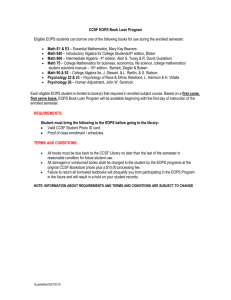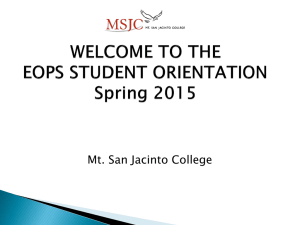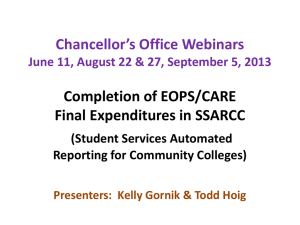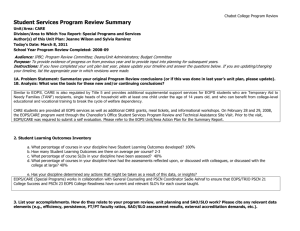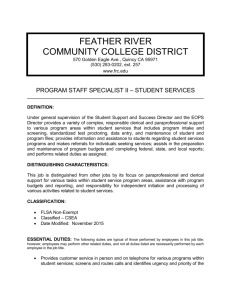Program Planning and Action
advertisement
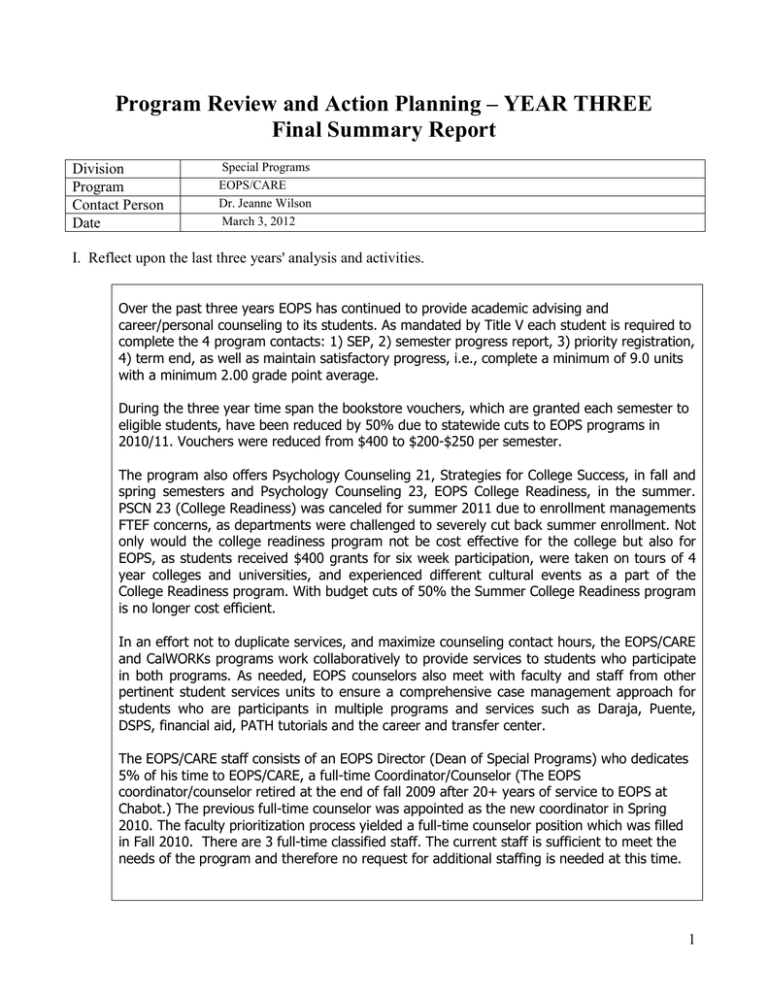
Program Review and Action Planning – YEAR THREE Final Summary Report Division Program Contact Person Date Special Programs EOPS/CARE Dr. Jeanne Wilson March 3, 2012 I. Reflect upon the last three years' analysis and activities. Over the past three years EOPS has continued to provide academic advising and career/personal counseling to its students. As mandated by Title V each student is required to complete the 4 program contacts: 1) SEP, 2) semester progress report, 3) priority registration, 4) term end, as well as maintain satisfactory progress, i.e., complete a minimum of 9.0 units with a minimum 2.00 grade point average. During the three year time span the bookstore vouchers, which are granted each semester to eligible students, have been reduced by 50% due to statewide cuts to EOPS programs in 2010/11. Vouchers were reduced from $400 to $200-$250 per semester. The program also offers Psychology Counseling 21, Strategies for College Success, in fall and spring semesters and Psychology Counseling 23, EOPS College Readiness, in the summer. PSCN 23 (College Readiness) was canceled for summer 2011 due to enrollment managements FTEF concerns, as departments were challenged to severely cut back summer enrollment. Not only would the college readiness program not be cost effective for the college but also for EOPS, as students received $400 grants for six week participation, were taken on tours of 4 year colleges and universities, and experienced different cultural events as a part of the College Readiness program. With budget cuts of 50% the Summer College Readiness program is no longer cost efficient. In an effort not to duplicate services, and maximize counseling contact hours, the EOPS/CARE and CalWORKs programs work collaboratively to provide services to students who participate in both programs. As needed, EOPS counselors also meet with faculty and staff from other pertinent student services units to ensure a comprehensive case management approach for students who are participants in multiple programs and services such as Daraja, Puente, DSPS, financial aid, PATH tutorials and the career and transfer center. The EOPS/CARE staff consists of an EOPS Director (Dean of Special Programs) who dedicates 5% of his time to EOPS/CARE, a full-time Coordinator/Counselor (The EOPS coordinator/counselor retired at the end of fall 2009 after 20+ years of service to EOPS at Chabot.) The previous full-time counselor was appointed as the new coordinator in Spring 2010. The faculty prioritization process yielded a full-time counselor position which was filled in Fall 2010. There are 3 full-time classified staff. The current staff is sufficient to meet the needs of the program and therefore no request for additional staffing is needed at this time. 1 It was recommended by the State Chancellors EOPS offices that during this challenging budgetary climate, colleges begin to collect data on EOPS’ impact on student success. In previous year’s analysis has been conducted by comparing EOPS student’s persistence rates to the collective body of NON-EOPS students at Chabot. Since EOPS is charged to serve the neediest of students who are from low income, first generation college families, we decided to conduct an “apples to apples” analysis of low income EOPS students compared to low income NON-EOPS students at Chabot. Data provided by Chabot’s Office of Institutional Research reveals EOPS students have higher rates of persistence from semester to semester compared to non-EOPS (92 percent vs. 77 percent). See graphs below. 2 When EOPS student GPA’s were compared to the general population of Non-EOPS students, (low income Non-EOPS student data was not available at time of analysis) EOPS students grade point averages were equivalent to Non-EOPS students GPA’s with variances of slightly lower or higher scores each semester. Being that EOPS targets low income, educationally disadvantaged students, we celebrate their ability to, despite their diversity of objectives, maintain GPA’s consistent to NON EOPS students who may not experience the same socioeconomic constraints. See graphs below. EOPS vs. NON-EOPS Grade Point Averages (GPA) 3 This data proves that the labor intensive follow up, intrusive counseling methods of EOPS, coupled with faculty and staff who are committed to helping these students reach their educational goals, really work! 4 II. Briefly summarize the accomplishments of the discipline, and how they relate to the review of the program, the program-level outcomes (PLOs) and course-level outcomes (CLOs). EOPS Accomplishment(s) )/Outcome(s): SLO: EOPS/CARE students will learn to utilize the EOPS/CARE program by completing the four, college mandated EOPS program contacts each semester to ensure students reach their educational goals in a timely manner. Service Area Outcome (SAO): EOPS Service Area Outcomes are to: 1. Determine the percentage of students who complete the 4 program contacts and whether completion of these contacts correlates in better retention and persistence rates. 2. Determine the number of students who complete certificates, AA/AS, and transfer in a timely manner. 3. Identify students who maintain a GPA below a 2.00 to provide them support services to assist the minimum bringing their GPA to 2.00 or above. By providing counseling services, psychology counseling classes, a bookstore voucher, and SBBC, the goal is to have approximately 25-35 EOPS students each year complete certificates and/or A.A./A.S. degrees and/or transfer. In addition, 80-85% of EOPS students will complete the 4 program contacts because our research has shown that students who complete these contacts are more successful in completing the minimum 9 units with the minimum 2.00 grade point than those who make no contacts. Thus enabling the students to advance toward their goal of transfer or completing an A.A./A.S. and/or certificate. In three years 65 African American males have participated in the Striving Black Brothers Coalition (SBBC). SBBC participants have transferred on to UCLA, Harvard, USC, CSU East Bay, San Jose State University, UC Davis, Morehouse, Clark University, Howard University, and San Francisco State University. Art Barboza, founder of SBBC was nominated for and awarded the Horseman Award, by (BWOPAC) Black Women Organized for Political Action & the Shining Star award by the Mayor of Hayward, for his retention efforts with African American males at Chabot College. CARE Accomplishment(s)/Outcome(s): Because CARE students are EOPS students, the CARE goals listed below are “additional” to the EOPS accomplished above. Because single parents have added responsibilities of caring for their families, the CARE program has continued to provide additional resources, grants and meal tickets, to supplement student’s annual income. CARE students who have an interest in developing soft skills and in self improvement, were offered informational workshops in collaboration with the CalWORKs program on topics such as: Resume Writing & Job Interviewing Techniques, Dress for Success, Stress Management, Money & Time Management, True Colors, Transfer, Career Exploration, Business Etiquette, etc.. 5 III. Please list what best practices (e.g., strategies, activities, intervention, elements, etc.) you would recommend? What was challenging? Was there a barrier(s) to success? Best practices: EOPS/CARE “best practices” support the college Strategic Plan goals and/or strategies in the areas of Student Success and Community Partnerships in the following areas: Provide academic advising, career and personal counseling Provide $200-250 bookstore voucher each semester Monitor student’s compliance in completing the 4 program contacts Continue Striving Black Brothers Coalition and Mentor Among Us programs. Collaborate with faculty in providing intervention services as listed on the semester progress reports 6. Collaborate with PATH center to provide over and above tutorial services 7. Established a program presence via social media to encourage students to check in regularly via Facebook, EOPS website, text or email, to receive current, relevant, up to date EOPS/CARE program/ message reminders about appointments, important events, and program updates. Challenges/Barriers to Success: 1. 2. 3. 4. 5. 1. Some students do not check their email regularly or do not have access to computers/email at home, making correspondence difficult. 2. Contemplation of going fully paperless has raised issues of access and affordability for students who may not have internet access from home, or do not have printers or the financial resources to use go print cards on campus to print all EOPS correspondence IE Mid-term progress report, priority registration and term end contact sheets. 3. Although “most” students have an cell phone and/or email access not all do; therefore email reminders of upcoming events, appointments and program contacts are not always received. 4. After moving to the new Student Service building 700, EOPS no longer has control over the educational climate in our area. Students often use computer kiosks as a social gathering site or opportunity to visit inappropriate websites, rather than a quiet study area, causing those students who are there to study to get distracted and frustrated. 5. While it was in our four year plan to provide at least 1 multi-cultural activity each semester and college tours to colleges and universities budgetary constrains have limited our ability to do so in 2010-2012. IV. Next Steps: Recommendations for program and institutional improvement. Program Improvement: Collaborate with other student services programs such as Daraja/Puente, Aspire, and Transfer, Employment, Career Services in offering workshops, multi-cultural activities and campus tours to 4 year Colleges and Universities. Institutional Improvement: Create a universal policy for “all” students services computers in Building 700 so students are held accountable and required to follow the same protocol and procedures while in the building. Find a way to monitor and limit computers access for non-academic usage. 6 7
